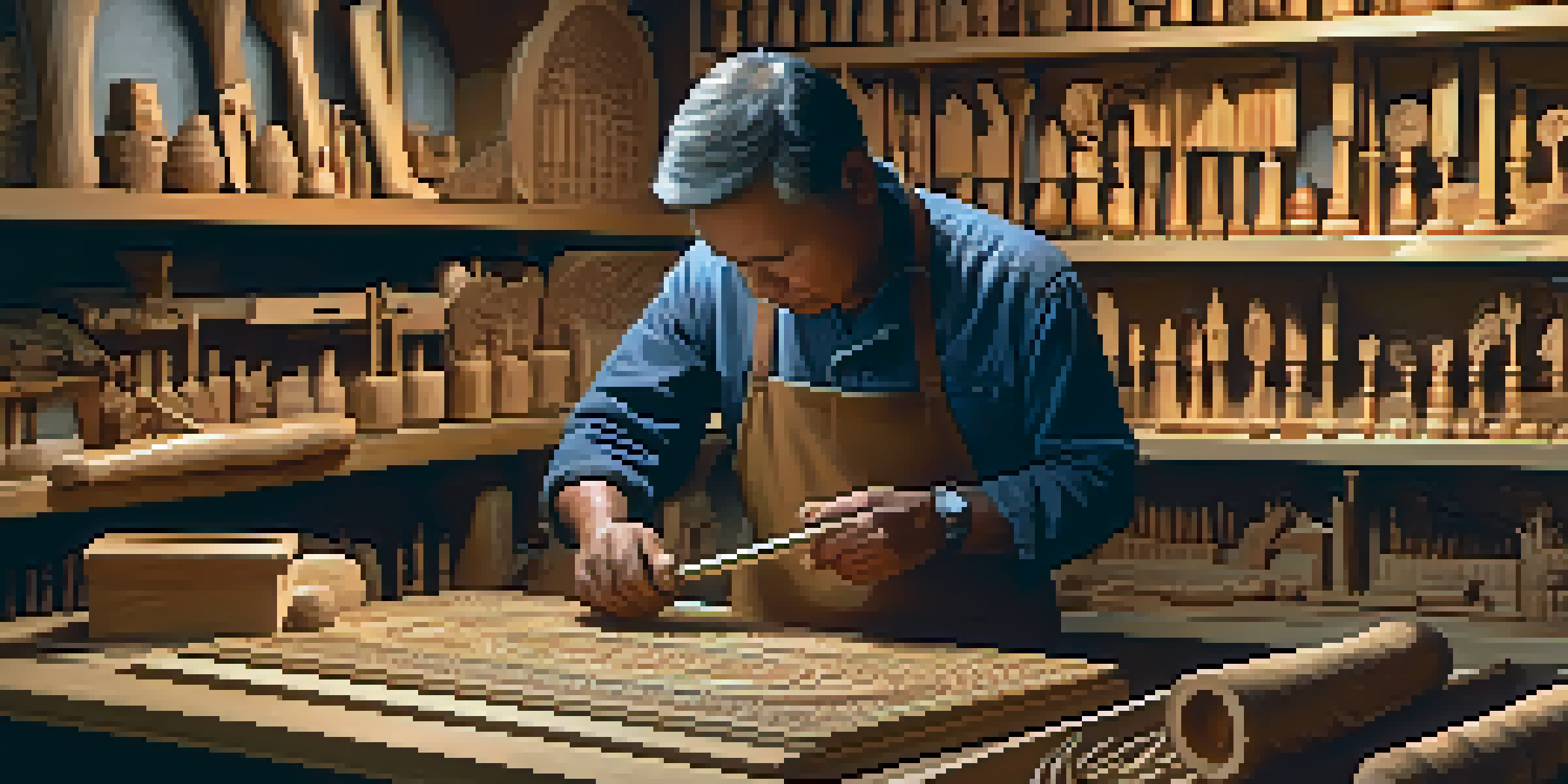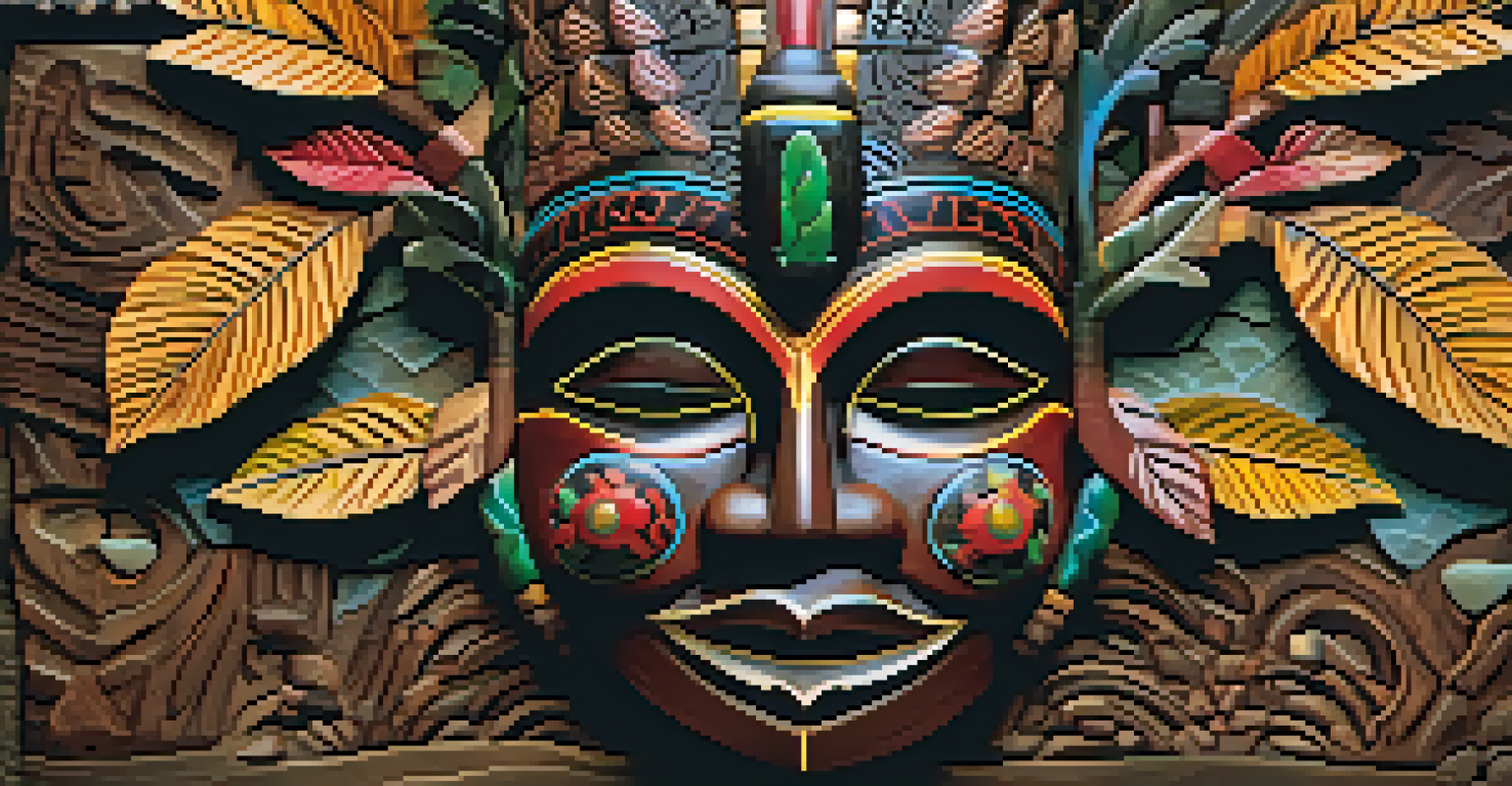The Origins of Carving: Ancient Techniques and Their Impact

Understanding Carving: An Ancient Art Form
Carving is one of the oldest artistic practices, dating back to prehistoric times. This technique involves cutting, shaping, and engraving materials like wood, stone, and bone, allowing artisans to create beautiful and functional objects. The beauty of carving lies not just in the artistry, but also in its ability to convey cultural narratives and values across generations.
Art is the most beautiful of all lies.
From the intricate designs of tribal masks to the monumental sculptures of ancient civilizations, carving has played a pivotal role in human expression. Artisans used available materials to reflect their surroundings and beliefs, creating objects that were both practical and ceremonial. This connection to culture and identity has allowed carving to endure through the ages.
In essence, carving transformed everyday objects into works of art, enriching the human experience. By understanding the origins of this craft, we can appreciate how these ancient techniques have shaped not just art, but also our shared history.
Early Carving Techniques: Tools and Materials
The earliest carvers relied on simple tools made from stone, bone, or wood. These rudimentary implements were essential for shaping materials and allowed artisans to create detailed designs. As societies evolved, so did the tools; metal chisels and knives emerged, enabling more precise and intricate work.

Materials varied widely, with wood being the most commonly used due to its availability and workability. However, stone, ivory, and even clay were also popular choices, each offering unique textures and characteristics. The choice of material often dictated the style and purpose of the carved object, influencing everything from ceremonial masks to everyday utensils.
Carving's Cultural Significance
Carving has historically served as a vital medium for expressing cultural identity, spirituality, and storytelling in ancient societies.
Understanding these early techniques provides insight into the ingenuity of our ancestors. Their ability to transform simple materials into meaningful art speaks to the human spirit's desire to create and communicate.
Cultural Significance of Carving in Ancient Societies
Carving has always been more than just a craft; it holds deep cultural significance. In many ancient societies, carved objects were imbued with spiritual meaning, often used in rituals or as offerings to deities. This connection to the divine made carving a revered skill, with artisans often held in high esteem within their communities.
Every artist dips his brush in his own soul, and paints his own nature into his pictures.
For example, the intricate carvings of the Maya civilization not only showcased artistic talent but also served as a record of historical events and religious beliefs. Similarly, African tribal masks were carved to represent ancestral spirits, bridging the gap between the physical and spiritual worlds. Each piece told a story, preserving cultural heritage for generations.
Thus, carving is a powerful medium through which cultures express their identities and beliefs. By studying these ancient practices, we can gain a deeper understanding of the values and traditions that shaped societies long ago.
Evolution of Carving Techniques Through the Ages
As time progressed, carving techniques evolved alongside advancements in tools and materials. The Renaissance period marked a significant shift, with artists like Michelangelo pushing the boundaries of carving into new heights. This era emphasized realism and emotion, leading to masterpieces that remain iconic to this day.
With the Industrial Revolution, carving saw a transformation from hand-crafted artistry to more mechanized processes. While this allowed for mass production, it also raised questions about the authenticity and uniqueness of carved objects. Many artisans sought to preserve traditional techniques, emphasizing the value of handmade craftsmanship.
Evolution of Carving Techniques
From primitive tools to modern technology, carving techniques have evolved significantly, reflecting artistic innovation and cultural shifts over time.
Today, we see a blend of ancient techniques and modern technology, creating a rich tapestry of carving styles. This evolution reflects not only changes in artistic preferences but also the dynamic nature of cultural expression and innovation.
Notable Ancient Carving Examples from Around the World
Across the globe, many remarkable examples of ancient carving highlight the diversity of this art form. The Great Sphinx of Giza, for instance, stands as a testament to the skill of ancient Egyptian artisans, showcasing intricate details and a sense of majesty. Similarly, the moai statues of Easter Island reveal the engineering prowess and cultural significance of carving in Polynesian societies.
In Asia, the intricate carvings of Angkor Wat reflect the spiritual devotion of the Khmer Empire, with scenes depicting mythological stories and daily life. Meanwhile, Native American totem poles serve as a visual narrative of heritage, representing clans and significant events through symbolic carvings. Each of these examples illustrates how carving serves as a powerful storytelling medium.
These ancient masterpieces not only showcase technical skill but also embody the cultural values and beliefs of their respective societies. They remind us that carving is a universal language, transcending time and geography.
Modern Carving: Reviving Ancient Techniques Today
In recent years, there has been a resurgence of interest in traditional carving techniques. Many contemporary artists are revisiting ancient methods, using them to create new works that honor the past while exploring modern themes. This revival reflects a growing appreciation for handcrafted artistry in an age dominated by mass production.
Workshops and classes dedicated to carving are becoming increasingly popular, allowing enthusiasts to learn skills passed down through generations. Artists and hobbyists alike are finding joy in the tactile experience of shaping materials by hand. This hands-on approach fosters a deeper connection to the craft and a greater appreciation for its history.
Revival of Traditional Carving
Contemporary artists are increasingly embracing ancient carving methods, blending traditional craftsmanship with modern themes to preserve cultural heritage.
By embracing these ancient techniques, modern artisans are not only preserving cultural heritage but also redefining what carving can be. This blend of old and new continues to enrich the art form and inspire future generations.
The Lasting Impact of Carving on Art and Culture
The impact of carving extends far beyond the objects created; it has shaped art and culture in profound ways. Carved artifacts provide valuable insights into the lives and beliefs of ancient peoples, serving as historical records. They connect us to our ancestors, allowing us to understand their experiences and worldviews.
Moreover, carving has influenced various artistic movements throughout history, from classical sculpture to contemporary installations. The techniques and principles established by ancient artisans continue to inform modern artists, fostering creativity and innovation across disciplines. This enduring legacy highlights the timeless relevance of carving in the art world.

Ultimately, carving remains a vital expression of human creativity and cultural identity. By studying its origins and evolution, we celebrate the artistry of those who came before us and recognize the ongoing significance of this ancient craft in our lives today.